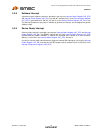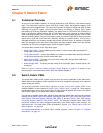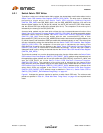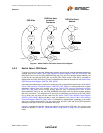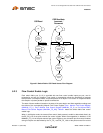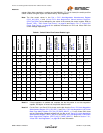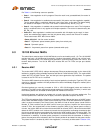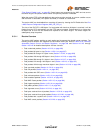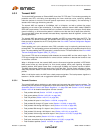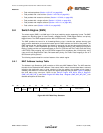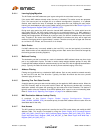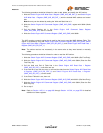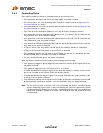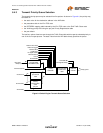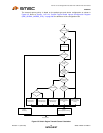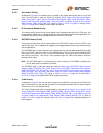
Two Port 10/100 Managed Ethernet Switch with 16-Bit Non-PCI CPU Interface
Datasheet
Revision 1.4 (08-19-08) 62 SMSC LAN9311/LAN9311i
DATASHEET
6.3.2 Transmit MAC
The transmit MAC generates an Ethernet MAC frame from TX FIFO data. This includes generating the
preamble and SFD, calculating and appending the frame checksum value, optionally padding
undersize packets to meet the minimum packet requirement size (64 bytes), and maintaining a
standard inter-frame gap time during transmit.
The transmit MAC can operate at 10/100Mbps, half- or full-duplex, and with or without flow control
depending on the state of the transmission. In half-duplex mode the transmit MAC meets CSMA/CD
IEEE 802.3 requirements. The transmit MAC will re-transmit if collisions occur during the first 64 bytes
(normal collisions), or will discard the packet if collisions occur after the first 64 bytes (late collisions).
The transmit MAC follows the standard truncated binary exponential back-off algorithm, collision and
jamming procedures.
The transmit MAC pre-pends the standard preamble and SFD to every packet from the FIFO. The
transmit MAC also follows as default, the standard Inter-Frame Gap (IFG). The default IFG is 96 bit
times and can be adjusted via the IFG Config field of the Port x MAC Transmit Configuration Register
(MAC_TX_CFG_x).
Packet padding and cyclic redundant code (FCS) calculation may be optionally performed by the
transmit MAC. The auto-padding process automatically adds enough zeros to packets shorter than 64
bytes. The auto-padding and FCS generation is controlled via the TX Pad Enable bit of the Port x MAC
Transmit Configuration Register (MAC_TX_CFG_x).
The transmit FIFO acts as a temporary buffer between the transmit MAC and the switch engine. The
FIFO logic manages the re-transmission for normal collision conditions or discards the frames for late
or excessive collisions.
When in full-duplex mode, the transmit MAC uses the flow-control algorithm specified in IEEE 802.3.
MAC pause frames are used primarily for flow control packets, which pass signalling information
between stations. MAC pause frames have a unique type of 8808h, and a pause op-code of 0001h.
The MAC pause frame contains the pause value in the data field. The flow control manager will auto-
adapt the procedure based on traffic volume and speed to avoid packet loss and unnecessary pause
periods.
When in half-duplex mode, the MAC uses a back pressure algorithm. The back pressure algorithm is
based on a forced collision and an aggressive back-off algorithm.
6.3.2.1 Transmit Counters
The transmit MAC gathers statistics on each packet and increments the related counter registers. The
following transmit counters are supported for each switch fabric port. Refer to Table 14.12, “Indirectly
Accessible Switch Control and Status Registers,” on page 309 and Section 14.5.2.25 through
Section 14.5.2.42 for detailed descriptions of these counters.
Total packets deferred (Section 14.5.2.25, on page 348)
Total pause packets (Section 14.5.2.26, on page 349)
Total OK packets (Section 14.5.2.27, on page 350)
Total packets 64 bytes in size (Section 14.5.2.28, on page 351)
Total packets 65 through 127 bytes in size (Section 14.5.2.29, on page 352)
Total packets 128 through 255 bytes in size (Section 14.5.2.30, on page 353)
Total packets 256 through 511 bytes in size (Section 14.5.2.31, on page 354)
Total packets 512 through 1023 bytes in size (Section 14.5.2.32, on page 355)
Total packets 1024 through maximum bytes in size (Section 14.5.2.33, on page 356)
Total undersized packets (Section 14.5.2.34, on page 357)
Total bytes transmitted from all packets (Section 14.5.2.35, on page 358)
Total broadcast packets (Section 14.5.2.36, on page 359)



